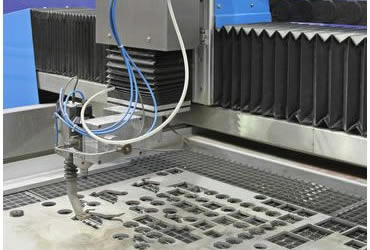
Not all cutting processes involve the application of a sharp cutting tool or blade to selectively remove sections of a workpiece. Water jet cutting, for example, relies on a controlled stream of pressurized water. When applied to a workpiece, the pressurized water literally blasts away sections of material. It’s a highly effective and precise cutting process that’s often preferred other conventional cutting methods.
#1) It Was Invented in the 1800s
Although it sounds complex and high tech, water jet cutting is actually an old cutting process with origins dating back to the mid-1800s. In the United States, mining companies used hydraulically pressurized water cannons to blast away dirt and minerals. A little less than a century later, water jet cutting made its way into the manufacturing industry where it’s since been used to cut workpieces with extreme precision.
#2) It Uses 0.5 to 1 Gallon of Water Per Minute
Statistics show that water jets use an average of just 0.5 to 1 gallons of water per minute. Surprisingly, that’s significantly less water than other devices uses. A standard garden hose, for example, uses around 8 gallons of water per minute. Based on these figures, water jets use anywhere from eight to 16 times less water than a garden hose.
#3) It Can Create Sharp Corners With an Accuracy of 0.001 inches
One of the reasons water jut cutting is preferred over other cutting processes is its ability to create extremely sharp corners with extreme precision. The problem with other cutting processes is that they often involve heat. When a workpiece is exposed to heat, its entire structural composition changes — even in areas that aren’t cut. Water jet cutting, however, doesn’t use heat, so it’s able to create sharp corners with an accuracy of just 0.0001 inches.
#4) It Can Produce Up to 1,600 PSI
Most water jets produce around 500 to 700 pounds per square inch (PSI) of pressure, but some of the more advanced water jets are capable of producing up to 1,600 PSI of pressure. With water blasting out the nozzle at 1,600 PSI, it’s able to slice through even the hardest surfaces.
#5) It Can Cut Through Most Materials
Dozens of materials can be cut using a water cut, some of which include steel, iron, rubber, plastic, stone, ceramics, glass, paper, foam, wood and composites. There are only a select few materials that can’t be cut with a water jet, such as diamond and tempered glass. With the exceptions of these materials, water cuts can cut through just about anything.
No tags for this post.